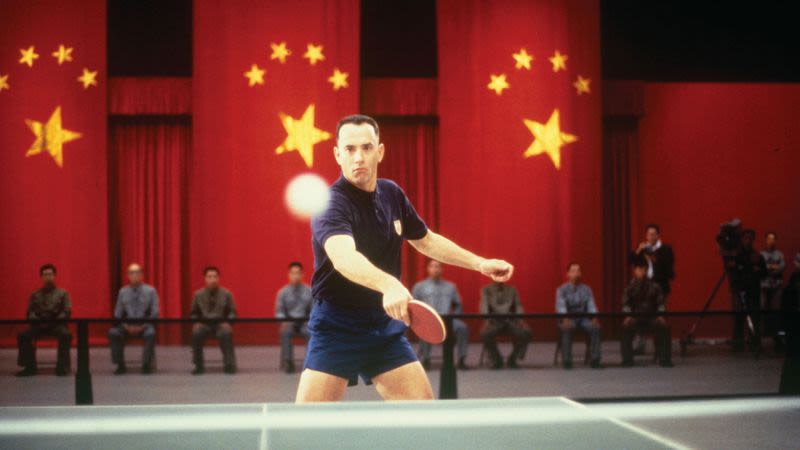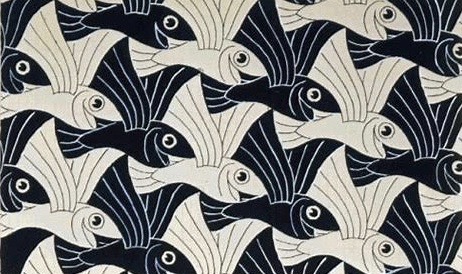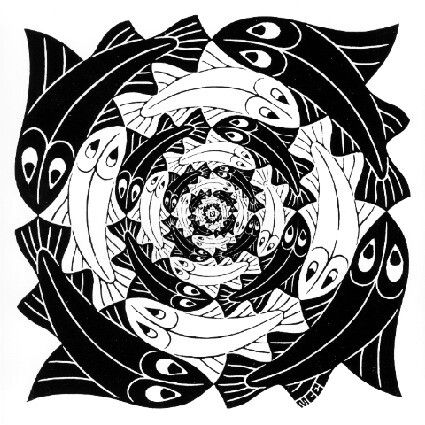
Here is the backstory to this curious phrase “Ping Pong Zen.”
Years ago I used to attend a men’s gathering at a lakeside conference center in southern Maine. The daily schedule started with spiritual practices at 7AM led by various attendees of the conference. One year I volunteered to offer a meditation practice session (which is a tough sell that early in the morning). I was assigned to the screened in porch section on the side of the main lodge. It was a long and narrow space with a ping pong table located in the middle doubling as a recreation room.
Since it was way too early in the morning to move furniture we just left the ping pong table where it was and seated ourselves around the circumference of the room. As the ping pong table was the dominant feature we made it the altar and decided to call our space “The Ping Pong Zendo” (Zendo is the Japanese word for sacred space or meditation hall in Zen).
Although I am a lousy ping pong player I’ve always been fascinated by the distinct sound of ping pong balls striking paddles and table (and sometimes the net) back and forth, back and forth…The term ping pong reminded me of the back and forth nature of yin and yang in eastern philosophy; the up and down, the this and that, the correlation of pairs and opposites. And from that one loosely associated thought “Ping Pong Zen” was born!
Since then I’ve attempted to organize a system that communicates the essentials of spiritual dynamics with a minimum of confusion (If that’s possible). This is my meager attempt. Ping Pong Zen is designed for the person with no philosophical or meditation background as well as the experienced practitioner with years of interest in religious/philosophical study. Ping Pong Zen introduces 10 terms or acronyms that can be used as a complete practice system. For the newcomer these terms provide a fresh starting point. For the long time follower of a practice tradition you are likely to note the common and universal truths simply in a new form.
Ping Pong Zen is organized into eight parts based on Aldous Huxley’s “Perennial Philosophy” published in 1945. These were originally a series of talks delivered at the Unitarian Society of Houlton in the winter or 2018. This is not an e-book but simply a collection of service notes and supplemental material garnered from these presentations and workshops. If you would like a copy just send a request to coffeebum61@gmail.com and I will email you the 85 page .PDF
Included below are a few samples from Ping Pong Zen:

Master Gump
Every religious tradition has its highly evolved master. In Ping Pong Zen the icon/guru is the unmatchable Forrest Gump. From the day he received the basic teaching of “Never, ever take your eye off the ball…” Gump practiced and practiced until he was so good Nixon sent him to China as the first American to visit the country in a million years or something like that.
In the Zen tradition one meditation technique is to practice facing a wall for hours on end. This is called “wall-gazing.” You may remember the scene in Forrest Gump where he is demonstrating his ping pong skills by practicing against a wall. The wall never misses and neither does Gump. In “The Making of Forrest Gump” they reveal how the special effects were key to transforming Tom Hanks (a pretty decent ping pong player) into Master Gump. In real life we don’t have the benefit of the special effects department, it simply comes down to focus and disciplined commitment. So if you need some inspiration along the arduous way to spiritual development, pop “Forrest Gump” into the Blue Ray player once in a while, enjoy some popcorn and then challenge someone to a good game of ping pong.
“Never, ever take your eye off the ball…”
************************
The Big Gulp
Zen has a saying, “Swallow the Pacific Ocean in a single gulp.”
If you remember 7Eleven’s famous drink “The Big Gulp,” that is what I think of when I hear “Swallow the Pacific Ocean in a single gulp.”
So how do you do that?!
Well, it’s impossible to do as your small ego-self (twoness), but easy to do if you recognize your universal self as connected to and one in the same as everything else (oneness).
You don’t swallow the ocean, you are the ocean.
You are not just the wave on the surface, you are part of and the ocean itself.
Realization is recognizing the wetness of the water itself. It is experiencing the wetness of the water on your face. This is realization (ONE).
The waves on the surface come in all shapes and sizes, but what each wave shares in common is its wetness. All waves are water and their true nature is ocean. This insight and this experience is what’s commonly known as touching your own true nature and you discover that it is characterized by love, compassion, light and luminosity. Waves in the ocean can be spiritual experiences, peak experiences, special metaphysical powers and abilities, ESP, visions, etc.. and oftentimes in the pursuit of enlightenment these experiences are mistaken for enlightenment or realization itself.
Waves can also represent the stage of spiritual development the individual has attained; the higher the wave, the higher the stage or the more advanced the level. Realization is not as much about the wave as it is the water. Realization is recognizing your true nature as the wetness of the water itself. The danger for the spiritual seeker is to spend their time and energy wave hopping instead of experiencing the water itself. You can touch the wetness of water no matter what wave you happen to be riding.

image by M.C. Escher
Splash Story
It was a rainy day and I needed to stop at our local Mardens and pick something up before I headed home. I have my window rolled down and I am waiting at the intersection for the traffic light to turn. I turn my head to the left to see how many cars are in the Marden’s parking lot and just as I do a car drives by and splashes water through my driver’s side window and the water hits me directly in the face! It felt like someone tossed a bucket of water at me. I never saw it coming and when it hit me square in the face I was instantly wide awake! Whatever I had been thinking about a moment before (What am I going to buy at Mardens? How much money do I have in my bank account? Are the Red Sox playing today?), was replaced by the here and now of the big splash. And it was the wetness of the splash that I remember most. I was drenched…
Realization is often described as being wide awake. It may be hard to describe what it is like, but you know it when you are. To be spiritually asleep or unconscious is characterized by confusion, distraction, frustration, suffering and arrogance and is usually driven by a maladjusted ego-self. To wake up is to be clear, alert, alive and attentive to what is. (the ego-self doesn’t get in the way) But as you’ve probably noticed, it’s difficult to maintain this awake state. We keep nodding off again.

image by M.C. Escher
So what are indicators of realization?
What we are looking for is a high spiritual intelligence score (SQ). The best indicators for spiritual maturity are not special powers, metaphysical abilities, cognitive intelligence about spiritual information or a professional religious title. These can all be misleading and detour us from the essential aspects of the spiritual life.
Simply ask your self these two questions:
- What is my level of interior peace and contentment?
- What is my level of compassion and self-less activity?
*
These may seem like simple and philosophically unsophisticated questions, but they are not.
Answer these questions as honestly as you can and you will have your answer.
Virtue is the evidence of enlightened qualities and an advanced stage in the spiritual life.
As will become obvious as you pursue these questions, the ego-self is the primary obstacle as well as the greatest ally in the process. (The self is used to liberate the self.)

image by M.C. Escher
Ping Pong Zen Meditation Practice (2XP)
Step One
breathe
relax
Step Two
Sit where you are and simply bring your awareness to the here and now. Notice what is going on inside you and around you. Maintain this awareness for as long as you choose. Consciousness itself is the essential ground of your being.
Commentary:
2XP is a centering method for the mind/body. It is the direct experience of your body and mind in the here and now. Instead of being distracted or up tight, we use our own awareness to notice our current state of being and make conscious adjustments to return to balance. Ever present awareness (EPA) is the key component to the process. We simply notice what is going on inside and outside of us and refrain from adding a running commentary.
What’s interesting is that the ego-self is being monitored along with everything else. As we use our own awareness to notice itself as well as the ego-self new insights arise regarding our own behavior. Once we see something in ourself it becomes more and more difficult to continue as if we didn’t see it. Our unconscious behaviors start to become conscious.
This method can be practiced extensively. Oftentimes it is used as a standard seated meditation practice for a specific amount of time but it can also be practiced anytime and anyplace. We bring the awareness of our awareness (AOA) to everything we do. Perhaps we try it out for short periods of time in certain circumstances, but eventually we extend it to more and more of our lifestyle. * Remember back in the 2XP instructions when I said I would make additional comments on the advantages of becoming aware of our own awareness? Well, using the 2XP method in this extended manner is a way to accelerate one’s progress through developmental stages of spiritual growth. Using our awareness like a mirror, and noticing the reflection of what’s going on is one of the best ways to take the ego-self out of action for a moment. The ego-self becomes less reactive and begins to become more transparent in its orientation. The problematic aspect of the ego-self is in direct proportion to its self-centric preoccupation. The 2XP method allows the ego-self to realign itself in the 10.0 system.
Here are the two primary aspects of the 2XP method:
- We recognize our point of reference (POR) as a human embodiment in the manifest world (10.0). We are centered and grounded in our body/mind.
- We recognize our ground of being as human consciousness itself, an invisible energy/information field related to a much larger energy/information field that is all inclusive. We are awareness. This ground of being is experienced as love, compassion, luminosity and calm. Everyone and everything arises from the same source. We are all one.
Step Three
Stabilizing the view:
Repeat step two as often as possible. When continual awareness (EPA) becomes your primary orientation your life will never be the same. Repeat. Repeat again.
Commentary:
We have access to this realm of being at all times, even when we forget it’s there or are unaware of it.
We have the capacity to experience our own positive innate qualities.
We do not attain anything new, we simply realize that it is there and was there the whole time.
*
Three Additional Practices:
One-Shot Zen, Two-Shot Zen
When you find yourself frazzled or off-center take a quick zen-break. This practice can be used any place and any time and no one will even notice you are doing it. I’ve used it plenty of times standing in line at the supermarket checkout. All it takes is one minute of your time.
Take one slow breath in and center yourself in the here and now.
Bring your awareness to the present moment and your body/mind.
I am here and now. This is what is.
Release the breath and with it any tension or resistance.
I am grounded in being.
That is “One -Shot Zen.”
If one shot doesn’t quite do it, go ahead and take a second shot.
*
Ground-Zero Practice
Years ago my Tai Chi instructor led our class in a training exercise where he asked us to “move from our center” while we did our form. He challenged us to focus on the source of our movement as we moved; to be aware of it, to feel it and to not lose track until we had completed the exercise. In Tai chi, the Tan Tien is the physical center and power center of the body. (The location is approximately two finger widths below the navel.)
This is what I call “Ground-Zero.” In Ground-Zero practice you center yourself in your physical body and combine that with your conscious awareness. You literally connect your brain (the top of the spinal column) with your Tan Tien (the bottom of your spinal column) and move. The challenge is to maintain that coordinated awareness not just for short practice periods but for extended lengths of time. Walking, jogging, vacuuming, or driving a car are all great opportunities for Ground-Zero practice. One of our teacher’s favorites sayings was “When the class is over the Tai Chi does not end.”
*
Twenty Four/Seven 24/7
As we have said before, ever present awareness (EPA) can be practiced for extended periods of time. This is what’s often known as a mindfulness practice and is typically applied to manual tasks, life circumstances as well as formal meditation. The term 24/7 is just another way of reminding ourself that the practice can be extended to any part of our daily schedule.
For more “Ping Pong Zen” just email me at coffeebum61@gmail.com and I will send you the file.

